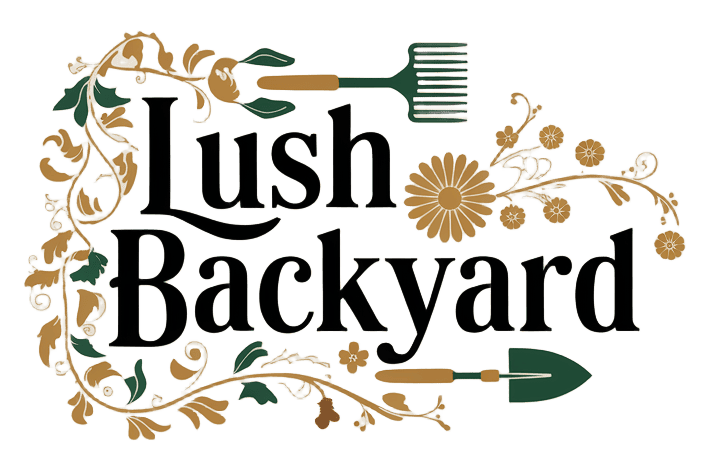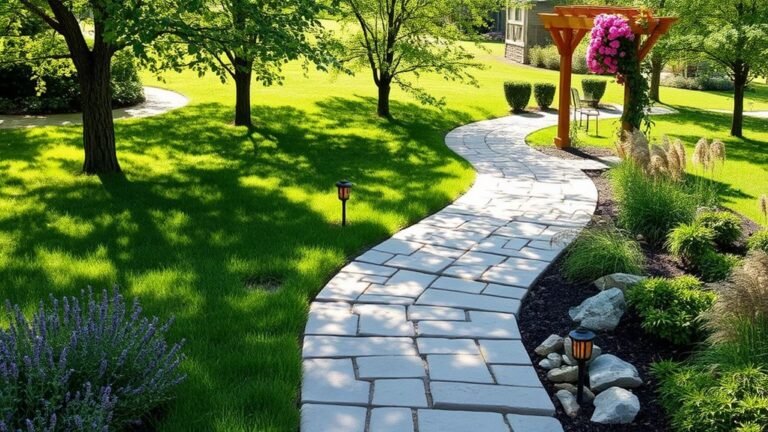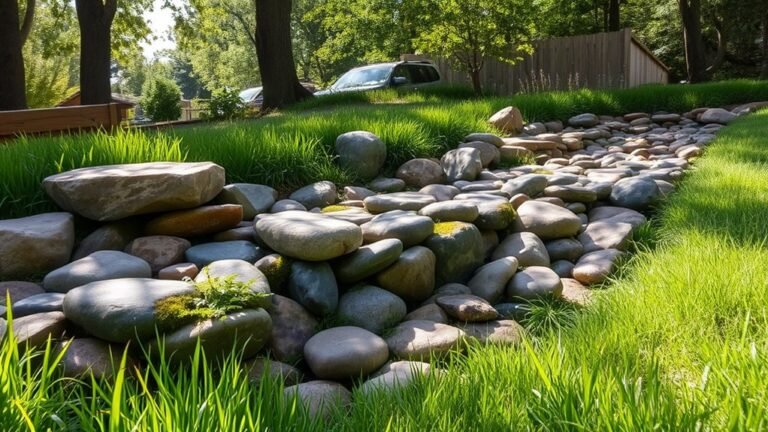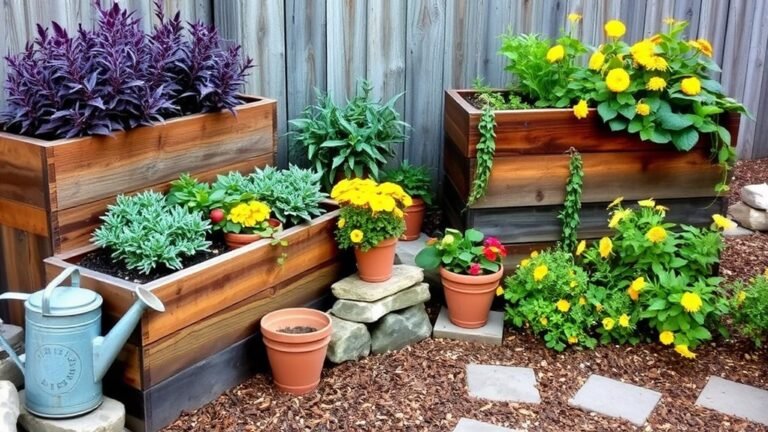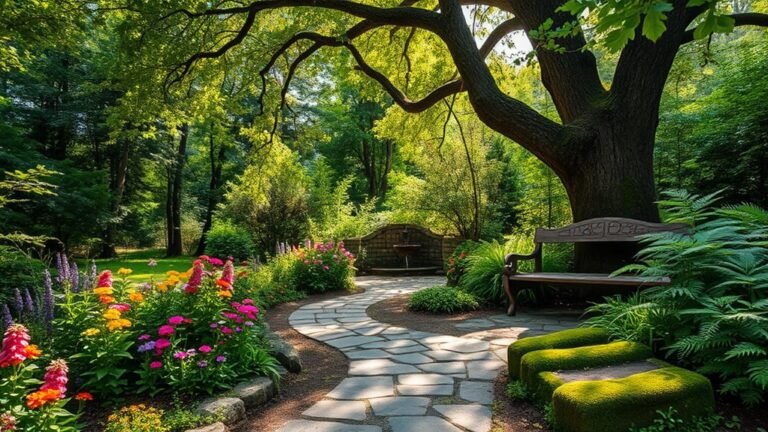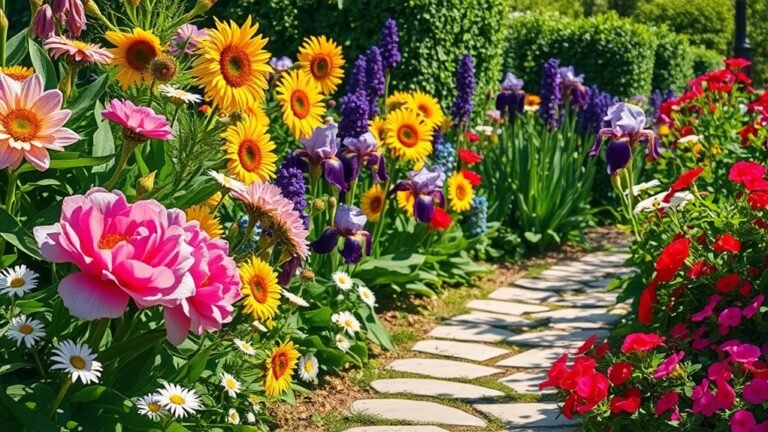13 Backyard Bird Sanctuary Ideas to Attract Wildlife
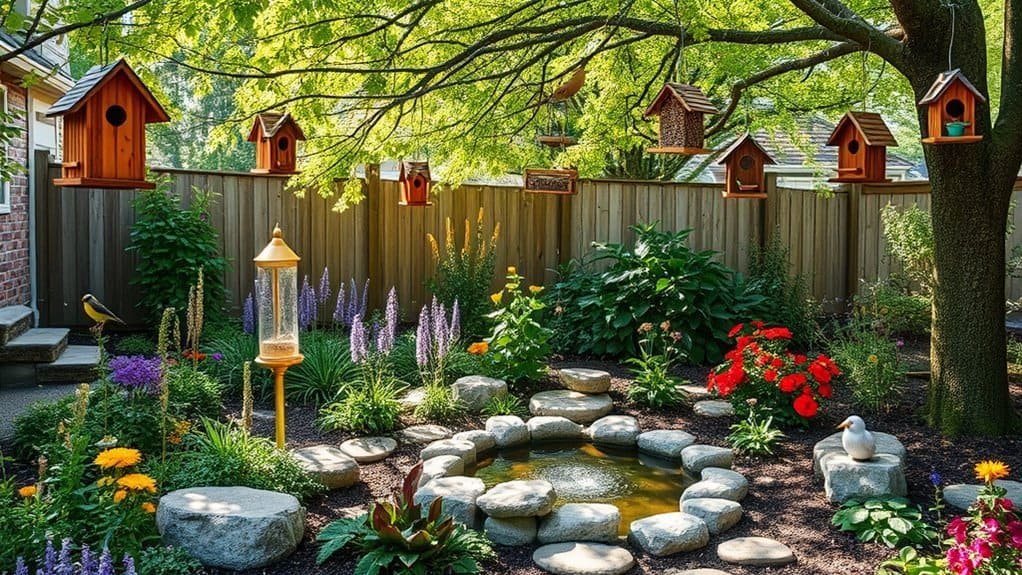
As spring approaches, it's the ideal time to enhance your backyard into a wildlife sanctuary. By making a few thoughtful changes, such as selecting native plants and adding bird feeders, you can attract a diverse array of birds and other wildlife.
Simple adjustments can significantly improve your outdoor space. Let's explore practical ideas to transform your backyard into a vibrant habitat.
Native Plants Selection
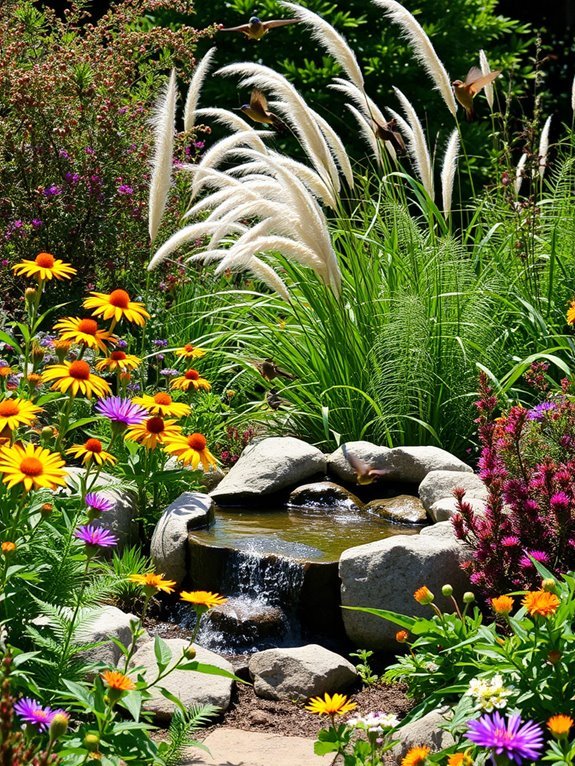
To create a vibrant bird sanctuary in your backyard, start with the right native plants. These plants are ideal as they offer food and shelter while thriving in your local climate with minimal care.
Incorporate a variety of shrubs, flowers, and grasses. Sunflowers, black-eyed Susans, and coneflowers attract finches and butterflies.
If space allows, plant berry-producing shrubs like serviceberries or elderberries, which birds love. Their foliage also provides cover from predators.
Don't overlook trees! Oaks, maples, and pines can serve as cozy nesting sites.
Bird Feeders Variety

Bird feeders are crucial for attracting diverse bird species to your sanctuary, offering numerous creative options.
Start with tube feeders for small songbirds like chickadees and finches, which cling on happily to munch.
Next, platform feeders serve as buffet tables for larger birds, such as jays and doves, allowing them to strut and snack in style.
Suet feeders are ideal for woodpeckers and insect-eating birds; they can be hung from trees or poles, transforming your yard into a gourmet dining spot.
For something more colorful, add a hummingbird feeder filled with sugary nectar to attract these acrobatic birds.
By incorporating a variety of feeders, you'll create a lively atmosphere perfect for birdwatching.
Just remember to keep them clean and filled regularly—your feathered friends are counting on it!
Set up your feeders and enjoy the birdwatching adventure!
Water Sources Installation
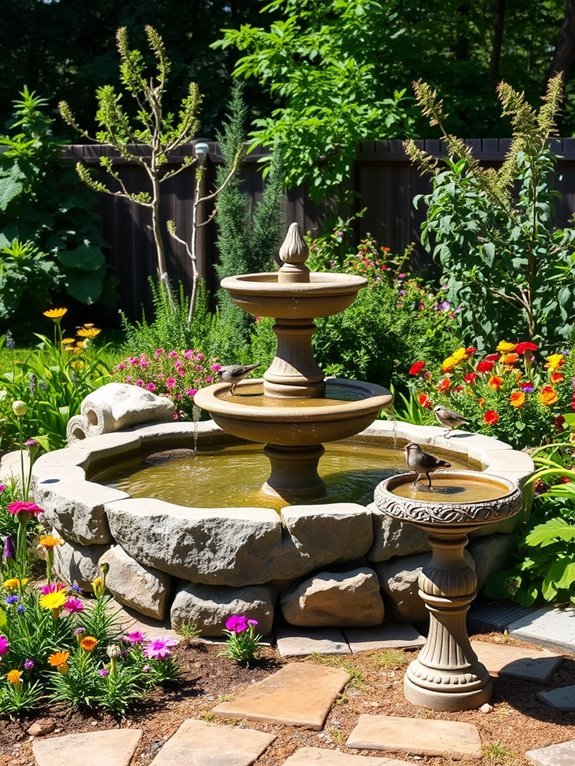
Providing a reliable water source is crucial for birds, aiding in their drinking, bathing, and cooling needs.
Here are some effective ways to attract them to your backyard:
- Bird Baths: Install a shallow bird bath with fresh water and add rocks or pebbles for perching. Remember to change the water regularly to keep it clean.
- Fountains: A small fountain offers continuous fresh water and soothing sounds, attracting birds to moving water.
- Water Dishes: Place shallow dishes of water around your yard for smaller birds who enjoy a cozy drink.
- Puddles: Create a small puddle area with a basin or tarp for birds to splash around.
These setups will transform your backyard into a bird paradise!
Nesting Boxes Placement
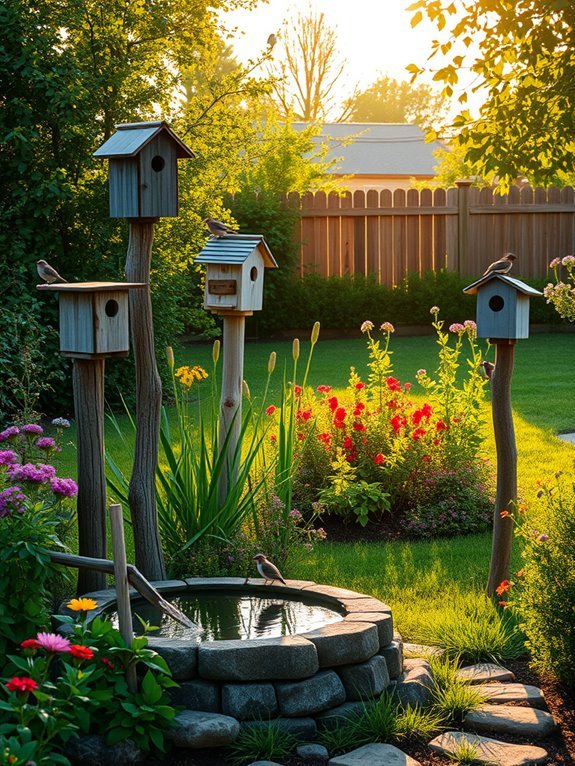
To create a bird-friendly sanctuary, strategically place nesting boxes in your backyard.
Mount them five to ten feet off the ground on sturdy poles or trees to protect young birds from predators.
Choose locations near shrubs or trees that offer cover, while keeping boxes spaced adequately apart to respect each bird species' territorial needs.
Ensure boxes face east to capture morning light, helping to maintain a warm interior.
Lastly, clean out the boxes at the end of the season for a fresh start each year.
Your backyard will soon attract a variety of feathered visitors!
Birdbaths for Hydration
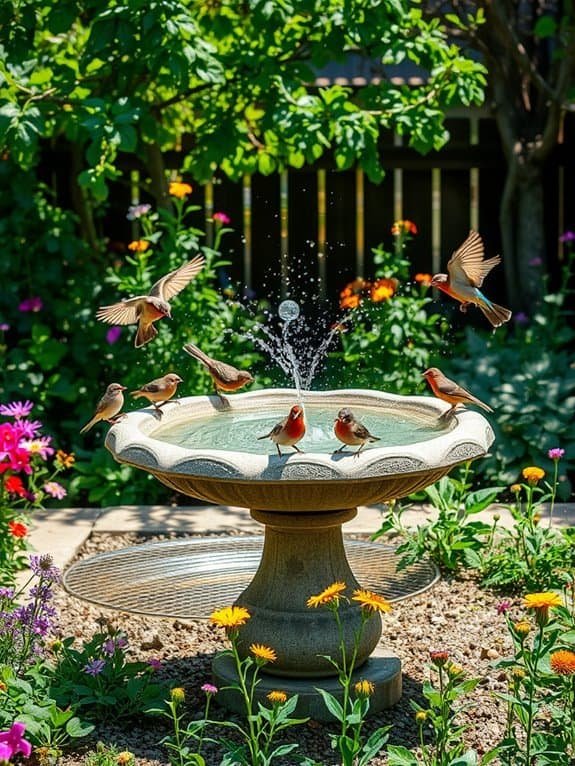
Enhancing your backyard for birds involves more than nesting boxes; a birdbath is essential for their hydration and bathing needs.
Here are four concise tips for selecting the ideal birdbath:
- Depth Matters: Choose a shallow birdbath, 1-2 inches deep, to keep birds safe while they dip.
- Location: Position the birdbath in a sunny area, away from dense shrubs, to help birds spot predators.
- Keep it Clean: Regularly refresh the water and scrub the bath to avoid algae, ensuring it remains inviting.
- Add a Feature: Opt for a birdbath with a fountain to draw in more birds with the sound of flowing water.
Shelter With Shrubs
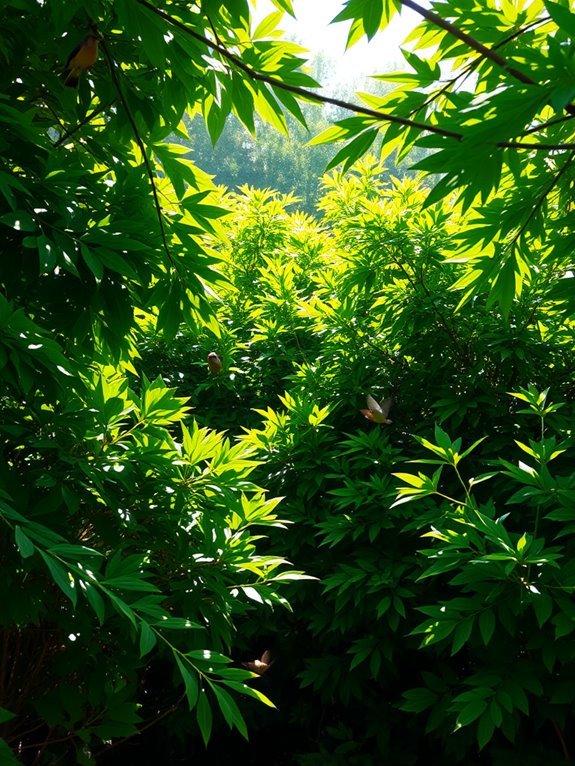
Creating a bird-friendly backyard is easy with shrubs that provide shelter and food. Birds prefer dense foliage for protection from predators and adverse weather. Here's a quick list of ideal shrubs that attract birds:
| Shrub Name | Benefits for Birds | Growth Height |
|---|---|---|
| Serviceberry | Berries and nesting sites | 6-25 feet |
| Elderberry | Berries attract different birds | 5-12 feet |
| Spicebush | Hosts caterpillars for bird snacks | 3-12 feet |
| Holly | Dense foliage for shelter | 5-15 feet |
| Dogwood | Berries for food and cover | 10-30 feet |
Planting these shrubs in clusters gives birds a secure environment for foraging. Their vibrant blooms also enhance your landscape. A little effort can significantly improve your backyard for birds. Get started on your planting, and your future avian visitors will appreciate it!
Perches and Fencing
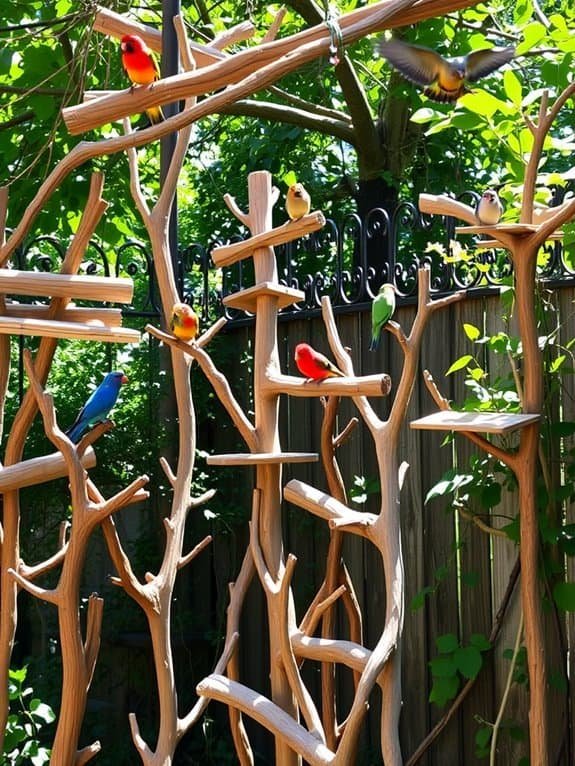
To enhance your backyard bird sanctuary, consider adding perches and fencing that attract and protect feathered visitors.
Perches provide birds with rest and vantage points, while fencing keeps predators away. Here are some ideas:
- Natural Branches: Sturdy tree branches serve as perches and add rustic charm to your sanctuary.
- Decorative Birdhouses: Colorful birdhouses can also act as perches, providing nesting spots and a delightful view.
- Wildflower Fencing: Plant wildflowers along your fence for beauty and to attract insects that birds enjoy.
- Trellises and Lattice: These structures can serve as perches while supporting climbing plants, offering cover and food sources for birds.
With these enhancements, you'll create an inviting haven for birds.
Happy birdwatching!
Butterfly Gardens
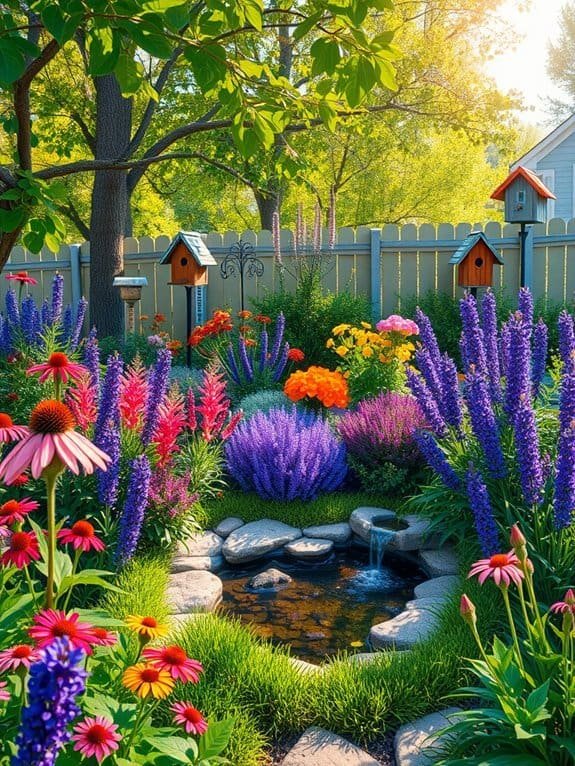
Butterfly gardens add vibrant charm to any backyard, attracting these delicate creatures with colorful, fragrant flowers.
To create your butterfly haven, plant a variety of nectar-rich species like purple coneflowers, butterfly bush, and zinnias, which not only look beautiful but also feed butterflies.
Incorporate host plants for caterpillars, such as milkweed for monarchs and parsley and dill for swallowtail caterpillars.
Provide sunning spots like flat rocks for butterflies to warm up.
Additionally, a shallow dish filled with pebbles and fresh water allows butterflies to drink safely.
You could even add a whimsical touch with a "Butterfly Café" sign.
With thoughtful planning and care, your butterfly garden will be the envy of the neighborhood, offering a delightful way to connect with nature.
Natural Pest Control
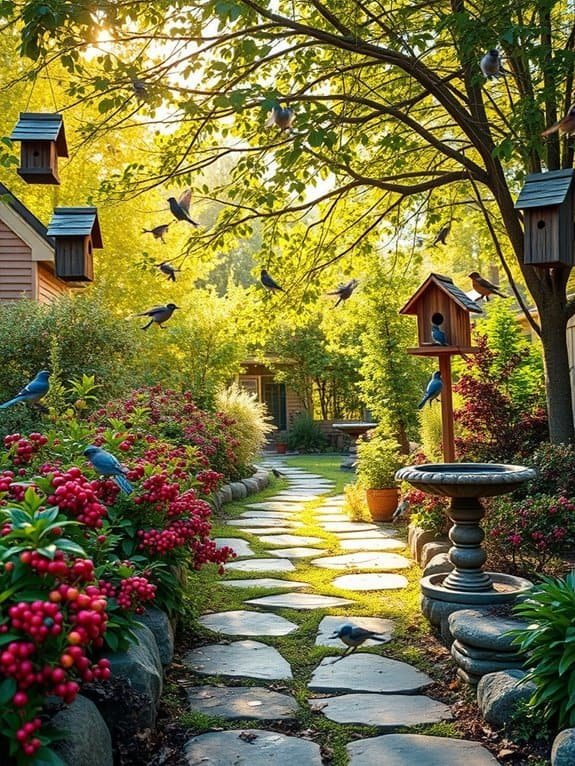
Creating a vibrant backyard attracts butterflies and other wildlife, establishing a balanced ecosystem and effective natural pest control. By welcoming beneficial creatures, you can manage pests without harsh chemicals.
Here are four helpful allies to encourage:
- Birds: Invite species like blue jays and wrens; they snack on insects, keeping pest populations down.
- Ladybugs: These charming bugs eat aphids and other garden pests. You can purchase them online for a quicker boost!
- Praying Mantises: These stealthy predators hunt down pests efficiently. Be cautious—they might also eat beneficial insects!
- Bats: These nocturnal flyers consume large quantities of mosquitoes and insects. Installing a bat house provides them a cozy roost.
Seasonal Food Offerings
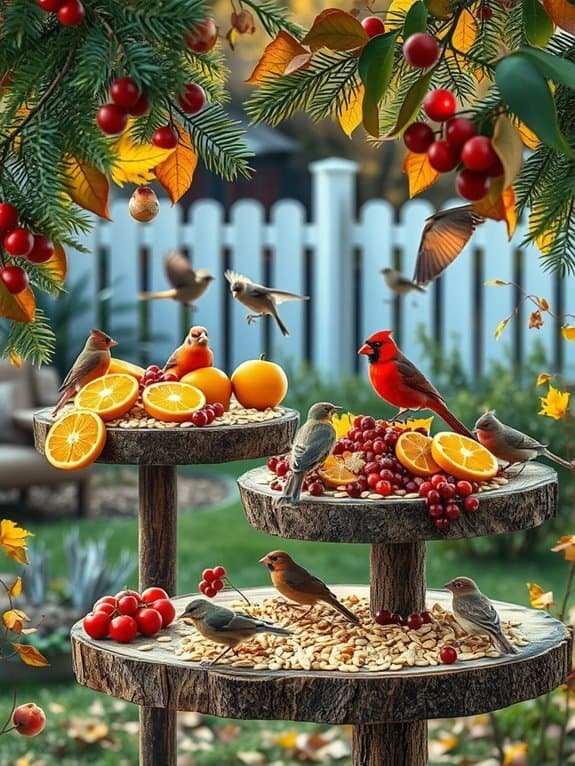
Enhancing your backyard sanctuary with seasonal food can attract a variety of birds.
In spring, offer suet and mealworms to provide nesting birds with a protein boost. As summer approaches, fill feeders with sunflower and thistle seeds, favorites among finches and sparrows.
In autumn, add fruits like apples and berries to draw migratory birds and create a colorful display. During winter, hang peanut butter-filled pinecones and provide black oil sunflower seeds for high-energy nourishment.
Keep feeders clean and well-stocked to enjoy lively feathered visitors year-round. Embrace the seasons for a delightful avian feast!
Educational Signage
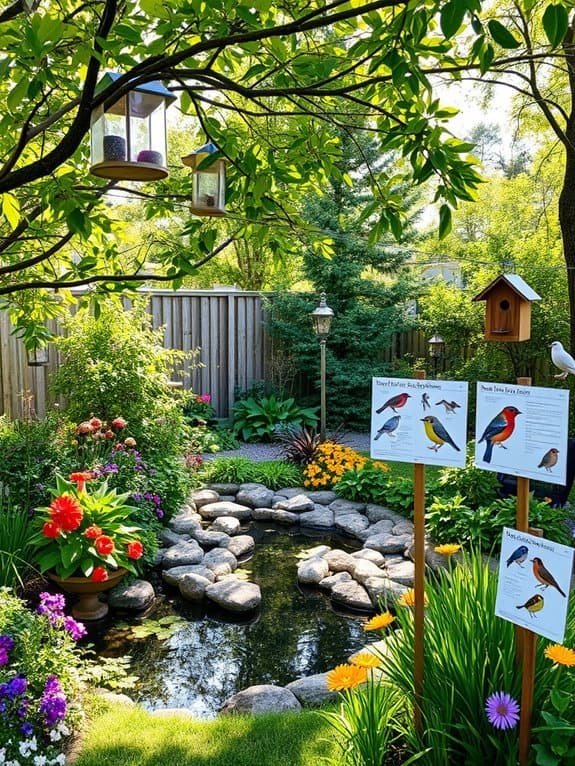
Enhance your backyard bird sanctuary with educational signage that informs visitors about local bird species. This not only enriches their experience but also encourages curiosity and conversation.
Here are some ideas for your signage:
- Species Spotlight: Feature a sign for each bird species with a photo, fun facts, and favorite snacks to turn guests into birdwatching experts.
- Bird Behavior: Provide insights on common behaviors like nesting and foraging, sparking engaging questions like, "Why is that bird doing the chicken dance?"
- Migration Maps: Create a simple migratory path map to help visitors understand the origins and destinations of their feathered friends.
- Local Habitat Tips: Offer tips on creating bird-friendly backyards, inspiring visitors to support avian life.
These signs will transform your sanctuary into an engaging hub of bird appreciation!
Wildlife-Friendly Mulch

To enhance your backyard bird sanctuary, consider using wildlife-friendly mulch to support local ecosystems. It not only looks appealing but also creates a habitat for beneficial critters like worms and insects that attract birds.
When selecting mulch, consider materials that benefit your feathered friends. Here's a quick comparison of popular options:
| Mulch Type | Benefits |
|---|---|
| Wood Chips | Long-lasting, moisture-retaining |
| Straw | Lightweight, insect-attracting |
| Bark Nuggets | Weed deterrent, drainage-enhancing |
| Grass Clippings | Nutrient-rich, easy to apply |
| Leaves | Free, encourages earthworms |
Year-Round Maintenance
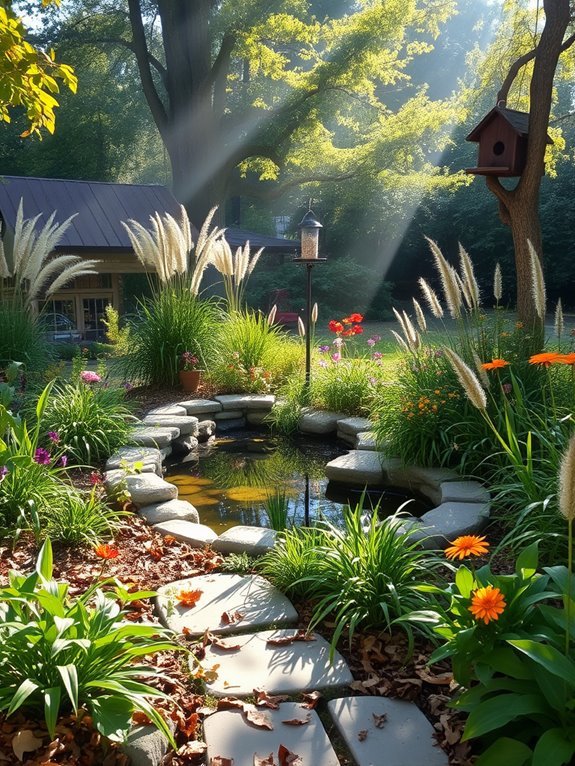
Maintaining your backyard bird sanctuary year-round is crucial for attracting diverse bird species.
Regular upkeep ensures your sanctuary remains inviting and thriving. Here are some concise maintenance tips:
- Clean Feeders Monthly: Wash feeders with soap and water, then rinse thoroughly to prevent mold and disease.
- Water Sources: Change and clean birdbaths or water dishes weekly to provide a refreshing oasis for birds.
- Seasonal Plant Care: Trim overgrown plants and replace dead ones to maintain a vibrant habitat.
- Monitor Nesting Sites: Inspect birdhouses and nesting boxes, cleaning them out after the nesting season to prepare for spring.
Frequently Asked Questions
How Can I Identify Local Bird Species for My Sanctuary?
To identify local bird species, grab a field guide or a bird identification app—these tools are like your birdwatching buddies!
Start by observing their colors, sizes, and unique features, like beaks and tail shapes.
Listen for their songs and calls; it's like they're chatting!
Keep a journal of your sightings—don't worry, it's not homework!
Soon, you'll be the bird expert in your neighborhood, impressing friends with your feathered knowledge!
Happy birdwatching!
What Is the Best Time of Year to Start My Sanctuary?
You'll want to kick off your sanctuary in spring!
That's when birds are busy nesting and looking for cozy spots. Starting then means you'll attract a bunch of feathered friends enthusiastic to check out their new digs.
Plus, you'll get to enjoy the lively chatter as they settle in. Just imagine sipping your coffee while watching all that action!
How Do I Keep Cats Away From Birds in My Yard?
Picture a feathered paradise, where the sun shines and birds chirp merrily.
To keep those sneaky cats away, you can create barriers like tall plants or garden fences. You might also sprinkle some citrus peels around, since cats aren't fans of that smell.
Install bird feeders high up, too!
And if you want to be extra clever, consider motion-activated devices that make noises. Your birds will thank you for the extra protection!
Are There Any Bird-Friendly Plants to Avoid?
When choosing plants for your garden, it's smart to avoid any that might be harmful to birds.
Stay away from toxic varieties like oleander or yew, which can make your feathered friends sick.
Instead, think about vibrant native plants that provide food and shelter.
Plus, they're way more fun to watch!
You'll be creating a lively space where birds feel safe, and you'll enjoy their cheerful presence, too!
How Can I Encourage Children to Participate in Birdwatching?
You might think birdwatching's just for quiet folks in binoculars, but it can be a blast for kids!
Start by making it a game—who can spot the most colorful bird? Create a simple checklist of local birds, and reward them with stickers or treats when they find one.
Encourage them to draw what they see, turning it into an art project!
With a little fun and creativity, you'll spark their interest in nature like never before.
Conclusion
Creating a backyard bird sanctuary is a wonderful way to celebrate nature. By incorporating native plants, feeders, and nesting spots, you'll attract a variety of feathered friends.
Don't forget the small details, like adding water sources or scattering seeds, that can make a significant impact. Put on your gardening gloves, embrace your inner bird enthusiast, and enjoy watching your yard come alive. Happy birdwatching!
